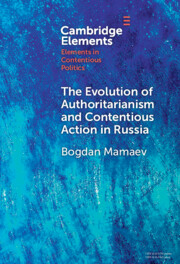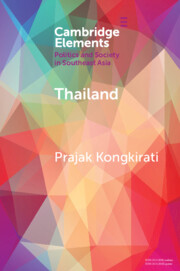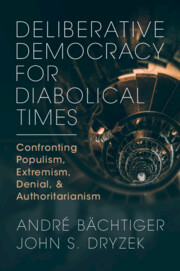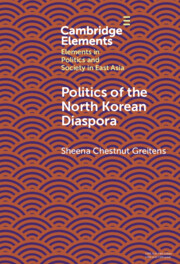350 results
1 - Setting the Scene
-
- Book:
- Hydropower in Authoritarian Brazil
- Print publication:
- 27 June 2024, pp 15-45
-
- Chapter
- Export citation

The Evolution of Authoritarianism and Contentious Action in Russia
-
- Published online:
- 30 May 2024
- Print publication:
- 20 June 2024
-
- Element
- Export citation
1 - Understanding How Campaigns Matter
-
- Book:
- Choices in a Chaotic Campaign
- Published online:
- 16 May 2024
- Print publication:
- 23 May 2024, pp 1-36
-
- Chapter
- Export citation
3 - The Origins of National Teacher Organizations
-
- Book:
- Mobilizing Teachers
- Published online:
- 16 May 2024
- Print publication:
- 23 May 2024, pp 35-69
-
- Chapter
- Export citation
1 - What Is the Kazakh Spring?
-
- Book:
- The Kazakh Spring
- Published online:
- 16 May 2024
- Print publication:
- 23 May 2024, pp 35-59
-
- Chapter
- Export citation
Chapter 14 - Renewing Democracy
-
-
- Book:
- The Cambridge Companion to American Utopian Literature and Culture since 1945
- Published online:
- 09 May 2024
- Print publication:
- 16 May 2024, pp 254-270
-
- Chapter
- Export citation
8 - Khameneism and the Absolute Velayat-e Faqih
-
- Book:
- How Islam Rules in Iran
- Published online:
- 02 May 2024
- Print publication:
- 09 May 2024, pp 264-296
-
- Chapter
- Export citation
9 - Whither the Islamic Republic?
-
- Book:
- How Islam Rules in Iran
- Published online:
- 02 May 2024
- Print publication:
- 09 May 2024, pp 297-304
-
- Chapter
- Export citation

Thailand
- Contestation, Polarization, and Democratic Regression
-
- Published online:
- 23 April 2024
- Print publication:
- 30 May 2024
-
- Element
- Export citation

Deliberative Democracy for Diabolical Times
- Confronting Populism, Extremism, Denial, and Authoritarianism
-
- Published online:
- 28 March 2024
- Print publication:
- 04 April 2024
7 - Conclusion
-
- Book:
- Fueling Sovereignty
- Published online:
- 14 March 2024
- Print publication:
- 21 March 2024, pp 193-210
-
- Chapter
- Export citation
5 - A Fascist Social Justice?
-
-
- Book:
- Social Justice in Twentieth-Century Europe
- Published online:
- 29 February 2024
- Print publication:
- 07 March 2024, pp 96-115
-
- Chapter
- Export citation
5 - Innovation–Development Detour in South Korea
-
- Book:
- Innovation–Development Detours for Latecomers
- Published online:
- 15 February 2024
- Print publication:
- 22 February 2024, pp 145-206
-
- Chapter
-
- You have access
- Open access
- HTML
- Export citation
Conclusion
-
- Book:
- Who Is a True Christian?
- Published online:
- 04 January 2024
- Print publication:
- 22 February 2024, pp 271-292
-
- Chapter
- Export citation
3 - Inhabiting the Rule
-
- Book:
- Who Is a True Christian?
- Published online:
- 04 January 2024
- Print publication:
- 22 February 2024, pp 128-175
-
- Chapter
- Export citation
5 - Rewriting the Rule
-
- Book:
- Who Is a True Christian?
- Published online:
- 04 January 2024
- Print publication:
- 22 February 2024, pp 230-270
-
- Chapter
- Export citation
Chapter 54 - The Threat of Pandemics to Interwoven Material, Social, Health, and Political Resources: Conservation of Resources as a Strategy for Avoiding Repeating Past Failure
- from Section 6 - Designing, Leading, and Managing Responses to Emergencies and Pandemics
-
-
- Book:
- Major Incidents, Pandemics and Mental Health
- Published online:
- 11 January 2024
- Print publication:
- 01 February 2024, pp 411-416
-
- Chapter
- Export citation
The Mediation of Autocratic Regimes: How Local Officials Shaped Authoritarian Systems in Rwanda and Sudan
-
- Journal:
- African Studies Review , First View
- Published online by Cambridge University Press:
- 08 January 2024, pp. 1-28
-
- Article
-
- You have access
- Open access
- HTML
- Export citation

Who Is a True Christian?
- Contesting Religious Identity in American Culture
-
- Published online:
- 04 January 2024
- Print publication:
- 22 February 2024

Politics of the North Korean Diaspora
-
- Published online:
- 17 December 2023
- Print publication:
- 18 January 2024
-
- Element
- Export citation



